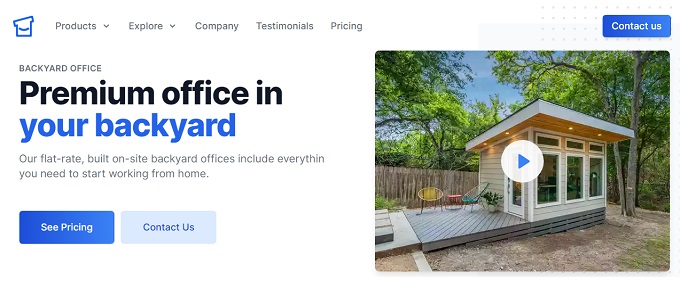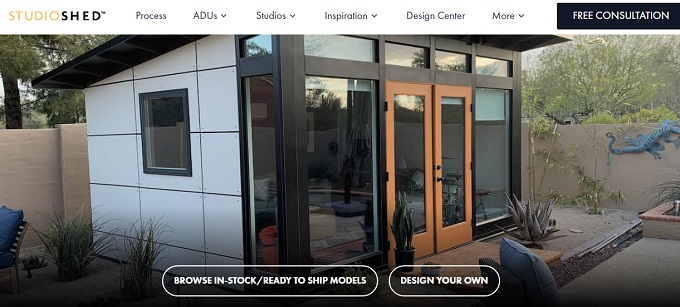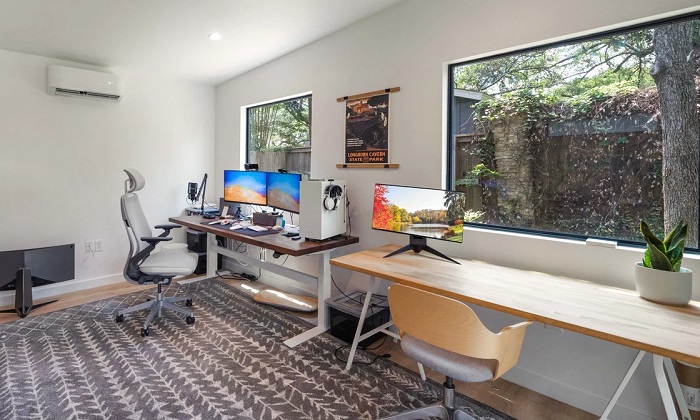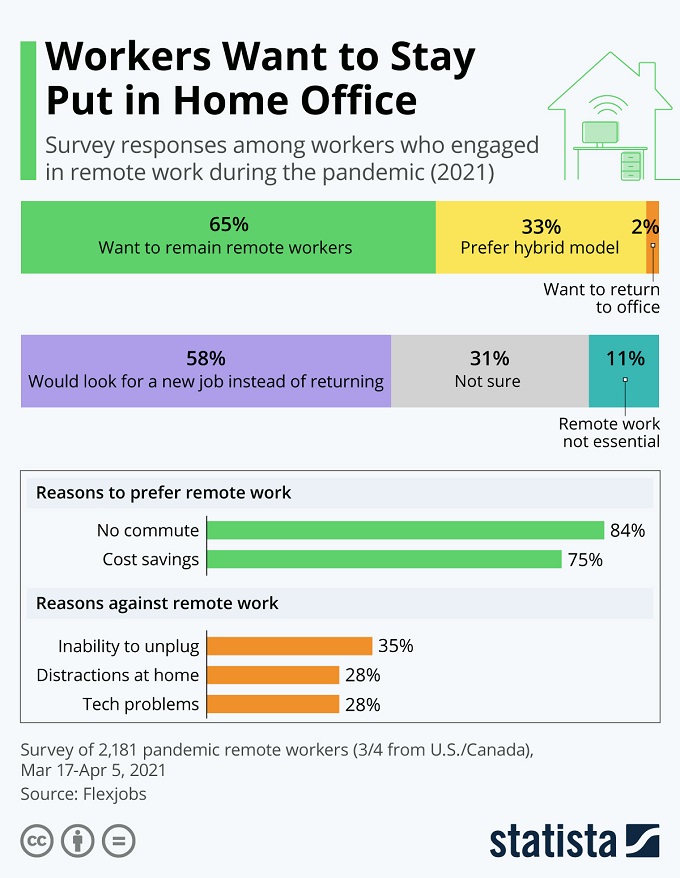Work from Home Offices a Popular Solution
The pandemic accelerated a national business and housing market trend that was already running hot in 2019 — working from home.
The reality of working and living at home, and getting work done isn’t so simple however and there is a need for solutions.
The backyard office is one such development with excellent promise, although hurdles exist to prevent this progress from happening.
The work from home evolution isn’t ending anytime soon. In fact is it offer huge benefits for the economy and the single family housing market shortage is a serious calamity that needs help. It’s likely the work from home with a backyard office suite will have a big impact on home builders, community design, HOA management, and home values.
A work from home, backyard suite might be one reason why homeowners will be willing to sell their current to acquire a home with the units. It’s that valuable.

There are niche builders providing just the right solution for those who own an appropriate residential property to create a high quality work from home workspace. A couple of companies, Studio Shed and Backyard Offices are two startups filling this trending demand in Texas and Colorado.
Work at Home Has Its Drawbacks
 Working in a small spare room with a small window or in the basement with no windows is a cruel fate for work from home workers. There are also direct distractions when in the home.
Working in a small spare room with a small window or in the basement with no windows is a cruel fate for work from home workers. There are also direct distractions when in the home.
And those working from a backyard deck, local café, or library find that situation lacking as well.
The need for and attraction of working from home really is compelling in terms of work satisfaction, productivity and maximizing living space which is a priority in the US. Millions of workers would prefer to work at home to avoid commuting time and costs, workday costs, clothing costs, workplace politics, managing kids at home, and accessing tax breaks for working at home, and to enjoy the efficiency of this alternative workstyle.
Many companies are virtual now, so there is no office to travel to. They must work at home.
Infographic courtesy of Statista.com. Worker preference for Work in Home Office
Why the Demand Exists
Current housing limits pose problems for a population that’s too large and a business world that needs cost reduction.
Residents are coming to see that current housing in the US and elsewhere is deficient in many dimensions – overcrowding, work at home, child home schooling and day care force them to move to get the space they need. Multifamily and apartment units were built for living only, and are completely inadequate for the new era of decentralized work — work at home.
Besides work performance one key factor in the work from home revolution is cost efficiency for workers and their employers. The virtual business environment is here to stay based on cost efficiency alone
The lack of work space is actually in a crisis state and poses health and productivity issues. Those who are fortunate enough to work at home discover emotional and health issues when they exist in one location 24 hours a day. Most houses and condos are not designed for that degree of continuous habitation. Working and living in a small apartment downtown could become an epidemic level health hazard, one which state and local governments along with apartment and multifamily industry developers have no solutions for.
However, home prices and financing are expensive and houses are in short supply, so moving the family to capture room in another neighborhood is not tenable. The solution is use the current living spaces better. Even current house owners find they can’t add a much desired office space to their home, and may also have a spouse who needs to work at home.
Additional Benefits of WFH
Add on the possibility of a rentable office space or Airbnb unit for some (larger unit models), it becomes an interesting possibility for added income. For some homeowners, the backyard office is a smart solution.
A work at home office suite offers substantial benefits for independent business owners, real estate agents, property managers, and remote IT workers. With commuting expenses, crime, air pollution, traffic congestion, and inflation adding stress and cost for most workers, the backyard office seems the perfect solution for them.
These offices can also be rented by a homeowner to other business people in the neighborhood who desperately need a quiet, private work location. Office rents in urban areas are very expensive, therefore backyard office rents of $500 to $2000 a month would not be outlandish.
Backyard Offices Austin Texas
Backyard Office is a startup business headquartered in Austin, Texas, launched by two brothers who recognized the opportunity of work from home from their own experiences. Sales rose gradually in 2020 during the pandemic and they report business continues to be brisk now in 2022.
They build constructed units that look a little like sheds, garages or granny flats but they’re modern, durable and building code compliant. The units contain electrical and HVAC systems of some type, and can range from 200 square feet and up. They build the units on site and plan to add kitchens and bathrooms in future.
Backyard Office is getting orders briskly despite some potential issues such as community zoning, local crime, and much cheaper alternatives available at home depot.
The key to their value proposition is customized sizing and features along with high quality design. Few remote workers would prefer to work in a garden shed with a single window repurposed for human occupation.
Studio Shed Louisville Colorado

Studio Shed is a builder in Louisville, Colorado which designs and builds customized backyard studios, prefab accessory dwelling units which can be used as work from home office spaces. Their prices start at about $14,000. As you can view on their website, the window space is expansive to help ward off any claustrophobic issues for some customers.
There are talented builders who can build similar structures for backyard pools and skating rinks. The structure can be a multi-use building. Below, DIY Pete shows how he builds units.
Having professionals do the job lends credibility and quality to the project which then helps ease opposition by local NIMBY legislators (who are contributing to the housing shortage).
Of course, most homeowners lack the construction skills to implement a project that involves pouring concrete, building the building, and installing utilities. These backyard office builds make more sense at the higher square footage floorspace level. The recent drop in lumber prices has helped make the projects more viable.
Plenty of homeowners have built their own garage, so these backyard office units are much more possible than most would realize. The home resale value could be profound.
The final word on backyard offices is that it is a needed housing market solution. The forecast for single family real estate is low supply, with work at home professionals needing to create their own solutions.
In states such as Colorado, California, Texas, Florida, Georgia, Pennsylvania, Massachusetts, Montana, and Ohio where property sizes are larger, the backyard office concept makes a lot more sense. And the single family housing market is destined to be chronically undersupplied and stressed.
The backyard office is a timely, valuable solution to the housing shortage and responds to the demands of the remote, virtualized work from home reality we’re now entrenched in. It solves a pressing problem for our economy and allowing workers to reach higher productivity levels which supports investments and the stock market.
See more on the housing market forecast.
Real Estate Housing Market | Housing Market Predictions for Next 5 years | Florida Housing Market | California Housing Market | Los Angeles Housing Market | Boston Housing Market | Denver Housing Market | Tampa Housing Market | Atlanta Housing Market | Sell My House | Software as a Service Marketing | Bleisure Travel Marketing | Travel Management Software | SaaS Marketing | Travel Marketing | Business Travel Marketing | Travel SEO


